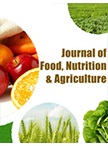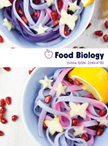Study on mineral, antinutrient and blood parameters of goats fed molasses treated rice husk
DOI:
https://doi.org/10.21839/jfna.2019.v2i1.236Keywords:
Rice husk, Buck, Weight gain, Serum minerals, Ruminant FarmersAbstract
A study on the nutritional potential of rice husk treated with or without molasses was carried out using 25 West African Dwarf (WAD) bucks. Five experimental diets were formulated such that; 0, 1, 2 3 and 4% molasses were incorporated in goat diets and were fermented for 5days before being fed to 25 WAD bucks of 5 replicates per treatment in a Completely Randomized Design experiment for 84 days. Results showed that, dietary treatments had significant (P<0.05) influences in all the parameters observed. Diet 5 had the highest crude protein (11.29%CP) and least crude fibre (26.51% CF). However, the dietary ash varied from 11.29% (Diet 5) to 19.84% (Diet 1). The mineral contents (Ca, P, Mg, K) of the diets progressively increased with increased inclusion of molasses and were adequate to support the growth of goats. The highest values were recorded in Diet 5 except for sodium which declined across the treatment. The anti-nutrients contents observed in this study were least in Diet 5 with exception of phenol which had the highest value (23.66%). Dry matter intake (DMI) varied from 466.86g/day (Diet 5) to 452.47g/day (Diet 1). Meanwhile, CPI increased with increased molasses in the diet. Bucks fed Diet 5 had the best mineral retention values and best daily weight gain (68.00g/day) as (6.86) feed gain ratio was the least. Consequently, treatment of rice husk with molasses at 4% inclusion level could improve the general performance of WAD bucks without any adverse effect on their health status.
Downloads
References
Abeke, F. O., Ogundipe, S. O., Dafwang, I. I., Sekoni, A. A., Abu, A. and Adeyinka, I. A. (2008). Effect of duration of cooking on the levels of some anti-nutritional factors of nine varieties of Lablab purpureus beans. Nigeria Journal of Animal Production, 35(2), 217-223.
Aderolu, A. Z, Iyayi, E. A. and Onilude,A. A. (2007).Changes in the nutritional value of rice husk during Trichoderma viride degradation. Bulgaria Journal of Agricultural Science, 13, 583-589.
Ahamefule, F. O., Ibeawuchi, J. A and Ibe, S. N. (2006). Nutrient intake and utilization of pigeon pea-cassava peel based diets by WAD bucks. Pakistan Journal Nutrition, 5, 419-424.
Aiello, S.E. (2002). The Merck Veterinary manual. 8th Eds. Merck and Co., white house, N.J., U.S.A.
Akinmutimi, A. H., and Ebuaraja, A.S. (2010). Effect of processing on nutrient and anti-nutrient composition of African yam beans (Spheostylis sternocarpa). Nigerian Journal of Agricultural, 4 (2), 99-107.
Badr M. F., and Abou-Akkada A. R. (1995). Rice hull as a substitute for wheat straw in feeding sheep. Alexandra Journal of Agricultural Research, 13(1), 1-10.
Belewu, M. A., and Ojo-Alokomaro, K.O. (2007). The effect of wattle tannin on intake, digestibility, nitrogen retention and growth performance of goats in South Africa. Livestock Research for Rural Development, 19(4), 148-154.
Cheeke, P. R., and Shull, L. R. (1995) Natural toxicant in feed and poisonous plants Avi publishing company, Westport, conn., U.S.A.
Cheesebrough, M. (2004). District Laboratory Practice in Tropical Countries Part 1. Low Priced Edition, Cambridge: Cambridge University Press.
Cork, S. C., and Halliwell R. W. (2002). The Veterinary Laboratory and Field Manual. A Guide for Veterinary Laboratory Technicians and Animal Health Advisors. University Press, Nottingham.
Daramola, S. O., Adeloye, A. A. Fatoba, I. A., and Soladoye, A. D. (2005). Haematological and biochemical parameters of West African Dwarf goats. Livestock Research for Rural Development, 17(8), 20-25.
Dargie, J. D., and Allonby, E. W. (1975). Patho-physiology of single and challenge infections of Haemochus cnotortus in Merino sheep. Studies of red cell kinetic and self-cure phenomenon. International Journal of Parasitology, 5, 147-157.
Hang, D. T., and Preston, T. R. (2007). Taro leaves as a protein source for growing pigsin central Vietnam. MEKARN International Conference on Matching Livestock systems with available resources (Edition T.R Preston and B. Ogle), 26-27 November, 2007, Ha Long Bay Vietnam http://mekarn.org/proham/abstracts/hang.hue.htm.
Ekanayake, S. D., Jansz, E. R., and Nair, B. M. (1999). Proximate composition, mineral and amino acid contents of mature Canavalia gladiate seeds. Food Chemistry, 66, 115 - 119.
FAO Statistical Database (2002). http://apps.fao.org
Fadiyimu, A. A., Alokan, J.A., and. Fajemisin, A.N. (2010). Digestibility, nitrogen balance and heamotological profile of West African dwarf sheep fed dietary levels of Moringa Oleifera as supplement to Panicum maximum. Journal of American Science, 6(10), 634 – 643.
Fasuyi, A.O., and Olumuyiwa, T.A, (2012). Evaluating nutritional potential of Bio-fermented rice husk in broilers diets. American Journal of Food and Technology, 7, 726-735.
Fasuyi, A. O., Dairo, F. A. S., and Ibitayo, F.J. (2010). Ensiling wild sunflower (Tithonia diversifolia) leaves with sugar cane molasses. Livestock Research of Rural Development, 22, 568-577.
Figueroa, V., and Ly, J. (1990). Growth performance of pigs fed hand-chopped sugar cane stalk. Livestock Research for Rural Development, Vol 16, Art. #14.
Frandson, R.D. (1986), Anatomy and Physiology of Farm Animals. Lea and Fabiger, Philadelphia. USA. Pp 174-189.
Hussein, H. S., Merchen, N. R., and Fahey, G. C. (1995). Effect of forage level and canola seed supplementation on site and extent of digestion of organic matter, carbohydrate and energy steers. Journal of Animal Science, 73, 2458-2468.
Ly, N. H., Am, L. V., and Ngoan, L. D. (2000). Evaluation of ensiled shrimps by-product for fattening pigs. Workshop-seminar making better use of local feed resources. SAREC-UAF. http://www.mekarn –org /sarpro/ngoan.htm.
McDonald, P., Edwards, R. A., Greenhalgh, J. F. D., and Moran, C.A. (1995). Animal Nutrition, fifth Edition. Pearson Education Limited, Edinburg gate Harlow, Essex, England. Pp.259-262.
McDonald, P., Edwards, R. A., Greenhalgh, J. F. D., and Moran, C.A., (2002). Animal Nutrition, 6th Eds., Longman Scientific and Technical, Harlow, Essex, England.
McDowell, L. R., (1992). Minerals in Animal and Human Nutrition. 1st Eds. Academic Press, New York, USA. 16, 431-436.
Merck’s Veterinary Manual. (1979). The Merck Veterinary Manual, 5th edition. Siegmund. O. H (Ed.,), Merck and Co. Inc. Rahway, New Jersey, USA. Pp. 1672.
Mohsen, M.K., Santiel, G. E., Mahmoud, S., and Basuni, M. I. (1993). Fermentation characteristicsand Nutritional value of corn cobs and rice straw ensiled with Monensin. Proceedings of Applied Research, Alexandria. Pp 104-114.
Nabaweya,E., Abaza, M. A., Nour, A. M., El-Shazly, K., and Naga, M.A. (1993). The nutritive valueof alkali treated rice straw for fattening lambs. Proceedings of Workshop on Applied Research, Alexandria. pp 115-121.
Ndams, S. S., Tegbe, T. S. B., and Ogundipe, S. O. (2009). Effect of feeding graded levels of re-fermented brewers’ dried grains on performance and carcass characteristics of broilers chicken. Journal of Agricultural Research, 1, 37-45.
Ba, N. X., Giang, V. D., and Ngoan, L. D. (2005). Ensiling of mulberry foliage silage for goats in central Vietnam. Hue University of Agriculture and Forestry Hue, Vietnam.
NMA (2014). Akure weather. Nigerian Meterological Agency (NMA) Archives, 1: 1 – 2. Nimet.gov.ng/akure-weather/12.5. Accessed on 12th March, 2017.
Norton, B.W (2003). The nutritive values of tree legumes as dietary supplement for ruminants. In: Tree legumes in tropica agriculture.(eds) Gutterridge , R.C., and Shelton, H.M. Pp. 59-61.
NRC (1981). Nutrient requirement of goats: Angora, dairy and meat goats inn temperate and tropical countries. Nutrient Requirement of Domestic Animals No.15. National Research Council, Washington D.C., USA.
Oboh, G., and Akindahunsi, A. A. (2005). Chemical Changes in cassava peels fermented with mixed culture of Aspergillus niger and two species of Lactobacillus integrated Bio-system. Applied Tropical Agriculture, 8, 63-68.
Ogle, B. (2006). Forage for pigs: Nutritional physiological practical implication workshop seminar Forage for Pigs and Rabbits MEKARN cell Agrid, phonom penln, Camboboa, 22 24 August 2006. Article #15 Retrieved Feb 8, 107 from http://www.mekarn.org/proprf/pgle.htm.
Ologhobo, A.D.; Tewe, O.O. and Adejumo, D.O. (1986). Hematological and neutral metabolites in broilers fed soyabean-based rations. Proceedings of 6th International Conference on Animal Production in the Tropics. Ahmadu Bello University, Zaria, pages 322-329.
Omotola, K. M., and Ikechukwu, A. (2006). Rice milling in Nigeria. http://www.ricenigeria.com.
Opara, M.N., Udevi, N. and Okoli, I.C. (2010): Haematological parameters and blood chemistry of apparently healthy West African Dwarf (WAD) goats In Owerri, South Eastern Nigeria. New York Science Journal. 3(8): 70-71.
Ranjhan, S. K. (1993). Animal Nutrition and feeding practices. 4th edition vikcas publishing House. PVT Ltd. New Delhi, India. Pp.142-150.
Ricks, M. (1996). Minerals: Small Ruminant Series Texas Agricultural Extention Services, Uvalde.Pp.65.
Roberts, K. M., Daryl, K. G., Peter, A. M., and Victor, W.R. (2003): Harper Biochemistry, 25th edition, Mc Graw-Hill, New York. 25:765.
SAS. (2008). User’s Guide: Statistics. Version 9.2, SAS Institute Inc., Cary, NC. USA.
Smith, J. W., Larbi, A. M., Jabbar, M. A., and Akinlade, J. (1996). Rumen degradation in sheep, goats and cattle in voluntary intake by sheep of four browse species. Agro-forestry Systems, 32, 277-286.
Staples, C. R. (1995). Bermuda grass; growing, storing and feeding for dairy animals. Curcular 1140, Florida co-op. Extension Services, Institute of Food and Agricultural Science, University of Florida, USA.
Tambuwal, F. M., Angale, B. M., and Bangana, A. (2002). Haematological and Biochemical values of apparently healthy Red sokoto goats. Proceedings of 20th Annual Conference Nigeria Society of Animal Production (NSAP), March, 17-21, 2002 FUT, Akure, Nigeria. Pp.50-53.
Tibbo, M., Jibril, Y., Woldermeskel, M., Daworf A., Aragaw, K., and Rege, J. E. (2008). Serum enzymes levels and influencing factors in three indigenous Ethiopian goats breeds. Tropical Animal Health Production, 4(8), 657-666.
Tony, H. (2013). How yeast can improve feed efficiency in ruminant. Cargil dairy news magazine. Tonad Publishers LTD, Ogun, Nigeria. Pp100-101.
Wyatt, D. J., and Weiss, W. P. (2004). Digestible Energy Value of diets with different fat supplements when fed to lactating dairy cows. Journal of Dairy Science, 87, 1446-1454.






 .
.